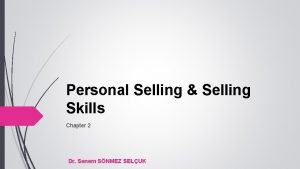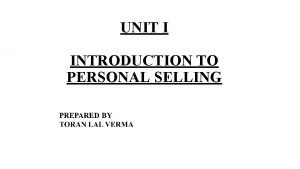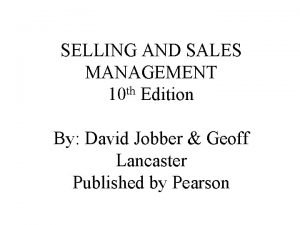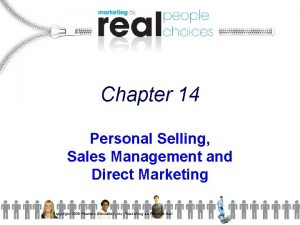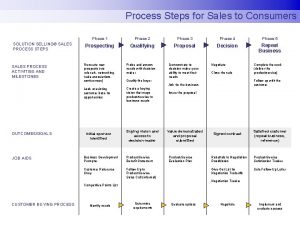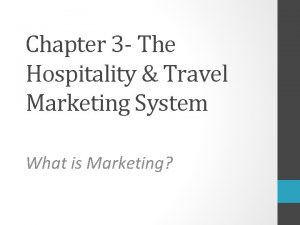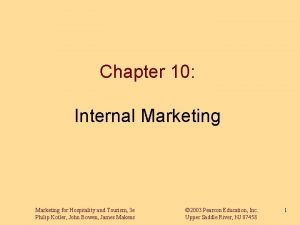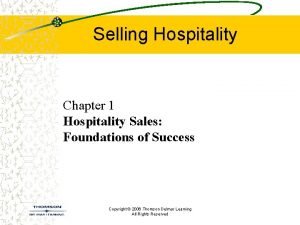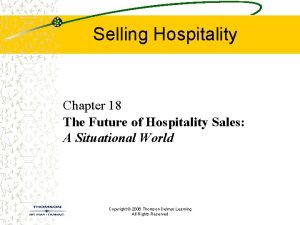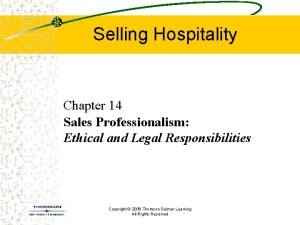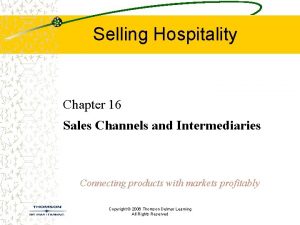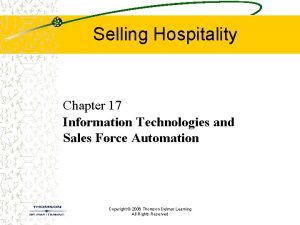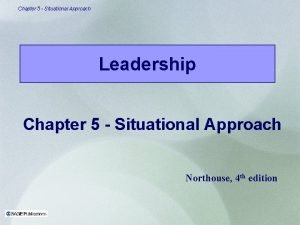Hospitality Sales and Marketing Situational Selling Chapter six












- Slides: 12

Hospitality Sales and Marketing Situational Selling Chapter six 1

Situational Selling § All buyers have different perceptions of value § Sellers must use different selling strategies and tactics and be able to tell which ones will be appropriate in different buying situations § The “situation” to be addressed reflects the value as perceived by both buyer and seller 2

Situational Selling § § § Both buyer and seller must answer a series of questions to arrive at an assessment of value The assessment drives the selling strategies for each “buying situation” Situation… 1. Is the industry in a state of perfect or imperfect competition? 2. Is there competitive differentiation? 3. Does the exchange involve complex or simple products? 4. In what stage of the product life cycle is the property? 3

Situational Selling § With perceptions in hand we address each situation with a few basic strategies and tactics – Strategies are the overall plans to help reach a goal – Tactics are things you can do that work toward reaching the goal…face to face behavior 4

Situational Selling § Situation #1: Perfect or imperfect competition – Several categories of competition § Monopoly…one supplier § Oligopoly…a few suppliers in an unofficial alliance § Imperfect competition…several suppliers but customers have limited access to product offerings § Perfect competition…several suppliers and customers have wide access to information about their product offerings 5

Situational Selling § Situation #2: Competitive differentiation – People generally buy on price when products have similar quality – Segment continually fights off commoditization – Low cost “go to market” selling strategies are employed 6

Situational Selling § Situation #3: Simple versus complex products and services – Simple products tend to compete on price – Complex products attempt to compete on value through relationships and product/service customization 7

Situational Selling § Situation #4: Product Life Cycle (PLC) – Introduction stage – Growth stage – Maturity stage – Optimization (Decline) stage 8

Situational Selling § Each stage requires a property to adjust the way it “goes to market”, or simply said, adjust its selling strategies – Introduction stage § Production is key. All sales are good sales § Key challenge is getting the product established – Growth stage § Increase prospect coverage. More sales people employed focusing on more market segments § Sales (and profits) grow rapidly § Key challenge is driving market share 9

Situational Selling § Each stage requires a property to adjust the way it “goes to market”, adjust its selling strategies – Maturity stage § § Begin to launch new products/services Begin defining most worthwhile customer segments Begin to discount to protect share Key challenge is preventing obsolescence or the decline stage – Optimization (or decline) stage § § § Begin to pursue targeted business…more narrow the focus… Optimize returns by creating lifetime customers Key challenge is how to develop and implement strategies that deliver value added solutions to targeted customers 10

Situational Selling § Basic value buyers are – Intrinsic – Extrinsic – Strategic § Basic selling strategies are – – Transactional Consultative Alliance Multiple channel selling strategy § Selling tactics are face to face actions – – Prospecting tactic…law of large numbers Negotiation tactic…can be win/lose or win/win Relationship tactic…problem solving “co-create solutions” Partnership tactic…Lets grow and change together (MPI example of streaming a meeting to a large audience “outside the room” 11

Situational Selling § Selling strategies are implemented to two ways – Individual approach – Team approach § Ad hoc teams § Formal teams 12
 Missionary selling definition
Missionary selling definition Situational selling
Situational selling Introduction of personal selling
Introduction of personal selling Marketing for hospitality and tourism
Marketing for hospitality and tourism Contoh sales management
Contoh sales management Selling and sales management
Selling and sales management Personal selling process in sales management
Personal selling process in sales management Solution selling process stages
Solution selling process stages Marketing for hospitality and tourism 7th edition ppt
Marketing for hospitality and tourism 7th edition ppt Travel marketing systems
Travel marketing systems Marketing in hospitality and tourism industry
Marketing in hospitality and tourism industry Marketing for hospitality and tourism pearson
Marketing for hospitality and tourism pearson Basic concepts of marketing
Basic concepts of marketing
